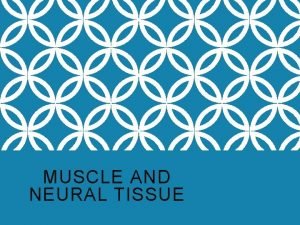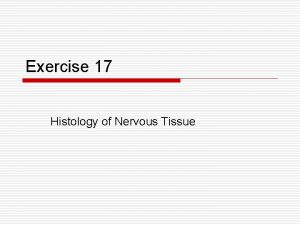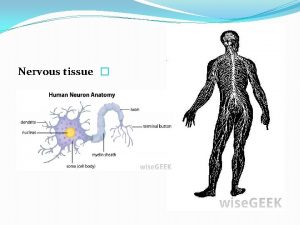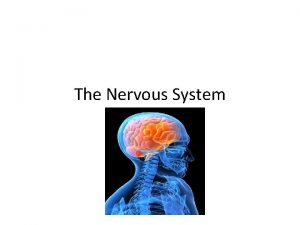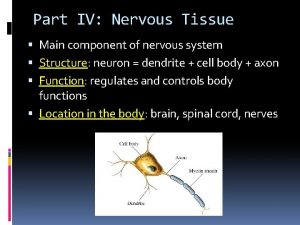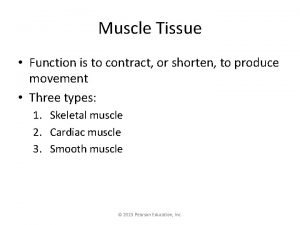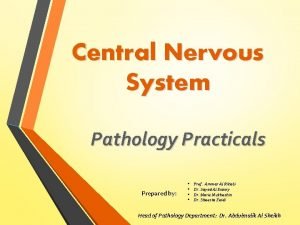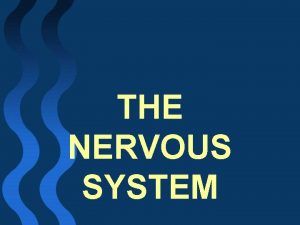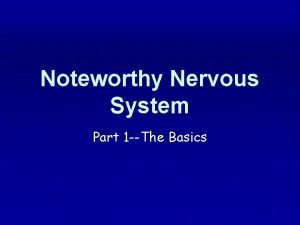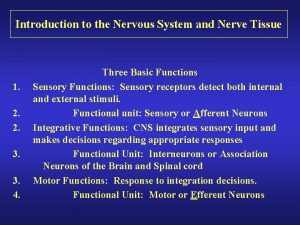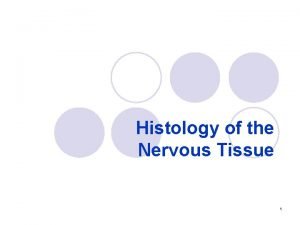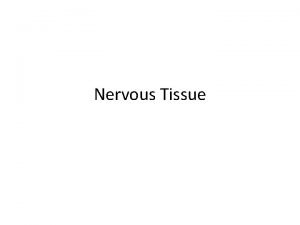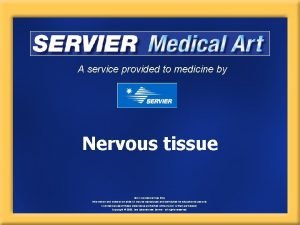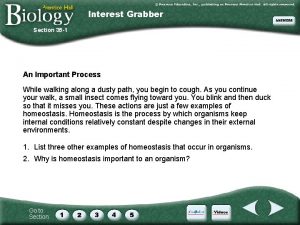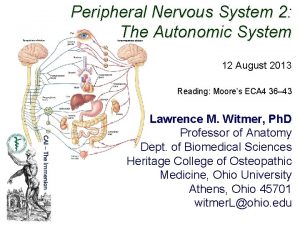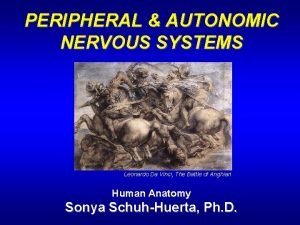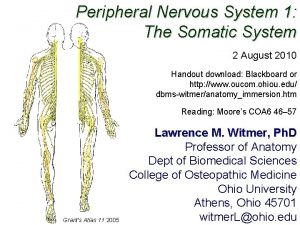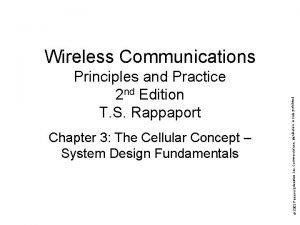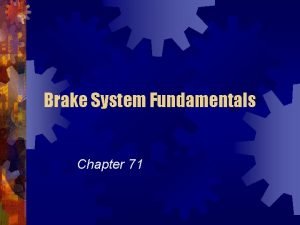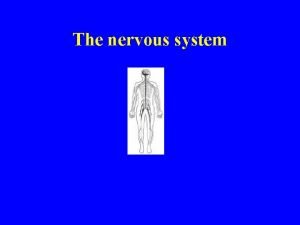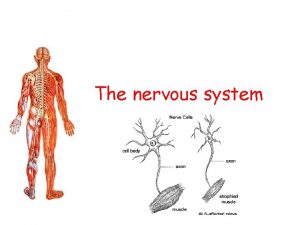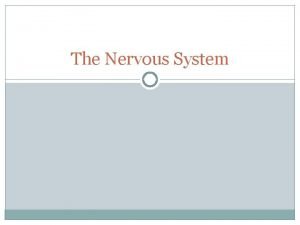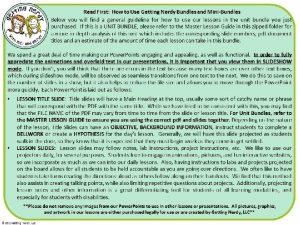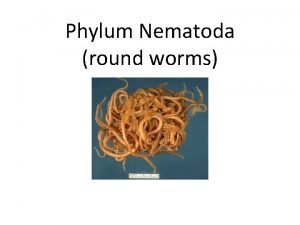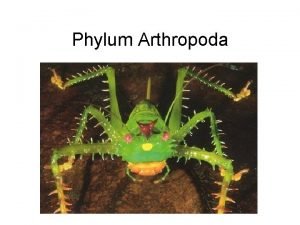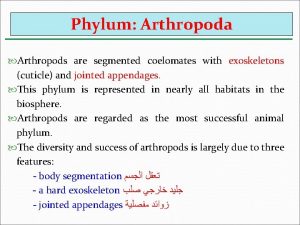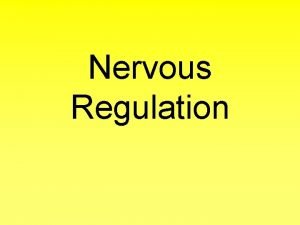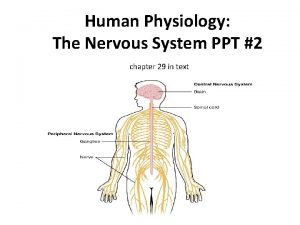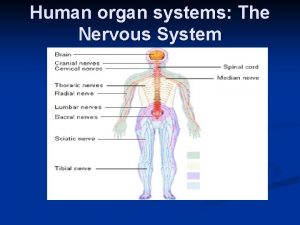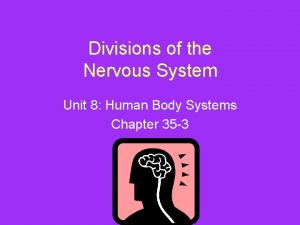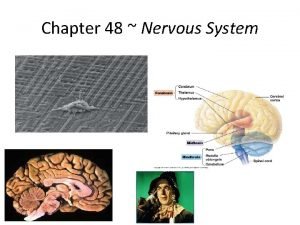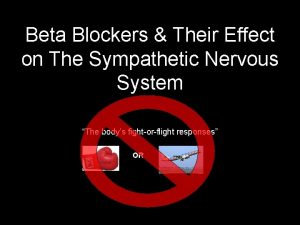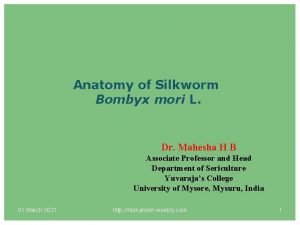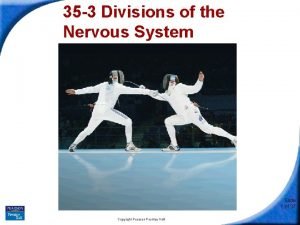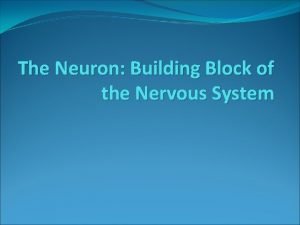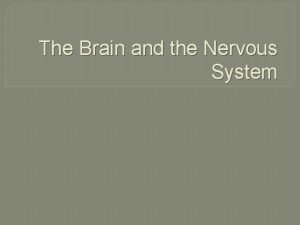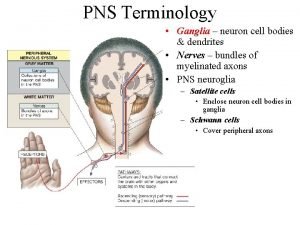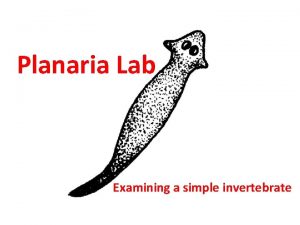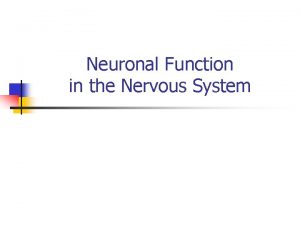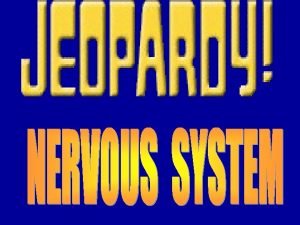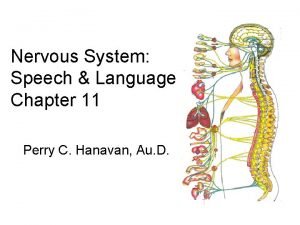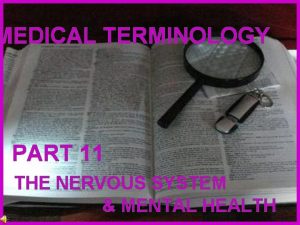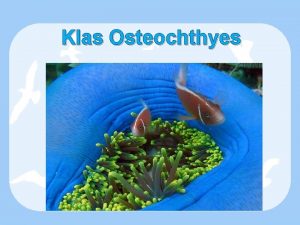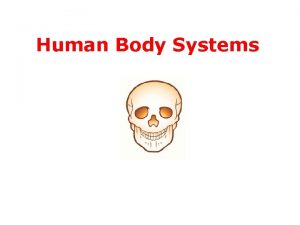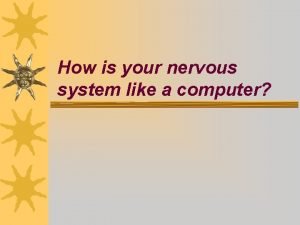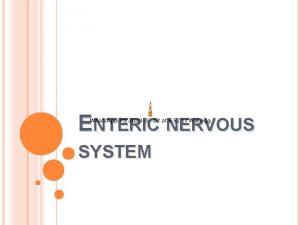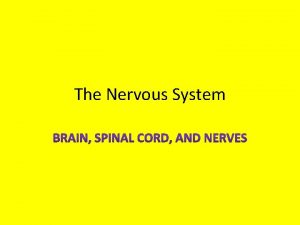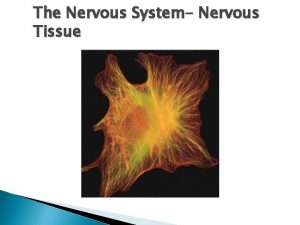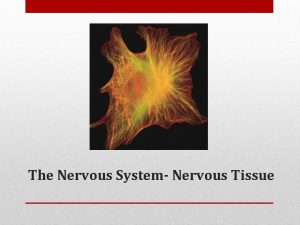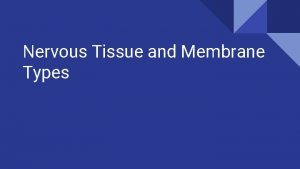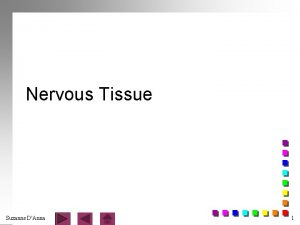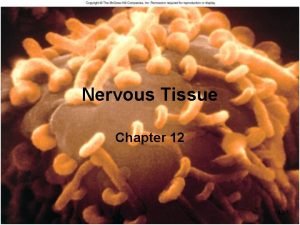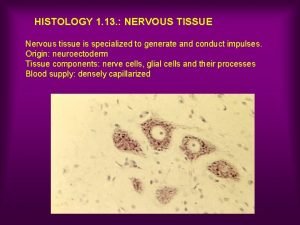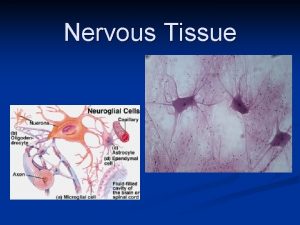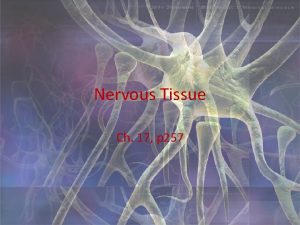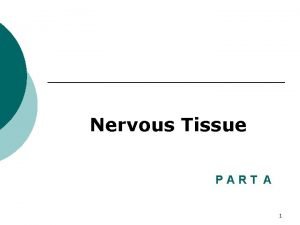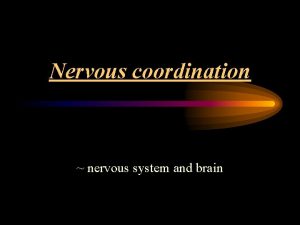Fundamentals of the Nervous System and Nervous Tissue
































































































































- Slides: 128

Fundamentals of the Nervous System and Nervous Tissue 11 Part A 1

Nervous System § The master controlling and communicating system of the body § Functions § Sensory input – monitoring stimuli occurring inside and outside the body § Integration – interpretation of sensory input § Motor output – response to stimuli by activating effector organs 2

Nervous System 3 Figure 11. 1

Organization of the Nervous System § Central nervous system (CNS) § Brain and spinal cord § Integration and command center § Peripheral nervous system (PNS) § Paired spinal and cranial nerves § Carries messages to and from the spinal cord and brain 4

Peripheral Nervous System (PNS): Two Functional Divisions § Sensory (afferent) division § Sensory afferent fibers – carry impulses from skin, skeletal muscles, and joints to the brain § Visceral afferent fibers – transmit impulses from visceral organs to the brain § Motor (efferent) division § Transmits impulses from the CNS to effector organs 5

Motor Division: Two Main Parts § Somatic nervous system § Conscious control of skeletal muscles § Autonomic nervous system (ANS) § Regulates smooth muscle, cardiac muscle, and glands § Divisions – sympathetic and parasympathetic 6

Histology of Nerve Tissue § The two principal cell types of the nervous system are: § Neurons – excitable cells that transmit electrical signals § Supporting cells – cells that surround and wrap neurons 7

Supporting Cells: Neuroglia § The supporting cells (neuroglia or glial cells): § Provide a supportive scaffolding for neurons § Segregate and insulate neurons § Guide young neurons to the proper connections § Promote health and growth 8

Astrocytes § Most abundant, versatile, and highly branched glial cells § They cling to neurons and their synaptic endings, and cover capillaries § Functionally, they: § Support and brace neurons § Anchor neurons to their nutrient supplies § Guide migration of young neurons § Control the chemical environment by buffering the potassium and recapturing neurotransmitters 9

Astrocytes 10 11. 3 a Figure

Microglia and Ependymal Cells § Microglia – small, ovoid cells with spiny processes § Phagocytes that monitor the health of neurons § Ependymal cells – range in shape from squamous to columnar § They line the central cavities of the brain and spinal column § They help circulate the cerebrospinal fluid 11

Microglia and Ependymal Cells 12 Figure 11. 3 b, c

Oligodendrocytes, Schwann Cells, and Satellite Cells § Oligodendrocytes – branched cells that wrap CNS nerve fibers § Schwann cells (neurolemmocytes) – surround fibers of the PNS § Satellite cells surround neuron cell bodies with ganglia 13

Oligodendrocytes, Schwann Cells, and Satellite Cells 14 Figure 11. 3 d, e

Neurons (Nerve Cells) § Structural units of the nervous system § Composed of a body, axon, and dendrites § Long-lived, amitotic, and have a high metabolic rate § Their plasma membrane functions in: § Electrical signaling § Cell-to-cell signaling during development 15

Neurons (Nerve Cells) 16 Figure 11. 4 b

Nerve Cell Body (Perikaryon or Soma) § Contains the nucleus and a nucleolus § Is the major biosynthetic center § Is the focal point for the outgrowth of neuronal processes § Has no centrioles (hence its amitotic nature) § Has well-developed Nissl bodies (rough ER) § Contains an axon hillock – cone-shaped area from which axons arise 17

Processes § Armlike extensions from the soma § Called tracts in the CNS and nerves in the PNS § There are two types: axons and dendrites 18

Dendrites of Motor Neurons § Short, tapering, and diffusely branched processes § They are the receptive, or input, regions of the neuron § Electrical signals are conveyed as graded potentials (not action potentials) 19

Axons: Structure § Slender processes of uniform diameter arising from the hillock § Long axons are called nerve fibers § Usually there is only one unbranched axon per neuron § Rare branches, if present, are called axon collaterals § Axonal terminal – branched terminus of an axon 20

Axons: Function § Generate and transmit action potentials § Secrete neurotransmitters from the axonal terminals § Movement along axons occurs in two ways § Anterograde — toward axonal terminal § Retrograde — away from axonal terminal 21

Myelin Sheath § Whitish, fatty (protein-lipoid), segmented sheath around most long axons § It functions to: § Protect the axon § Electrically insulate fibers from one another § Increase the speed of nerve impulse transmission 22

Myelin Sheath and Neurilemma: Formation § Formed by Schwann cells in the PNS § A Schwann cell: § Envelopes an axon in a trough § Encloses the axon with its plasma membrane § Has concentric layers of membrane that make up the myelin sheath § Neurilemma – remaining nucleus and cytoplasm of a Schwann cell 23

Myelin Sheath and Neurilemma: Formation 2411. 5 a-c Figure

Nodes of Ranvier (Neurofibral Nodes) § Gaps in the myelin sheath between adjacent Schwann cells § They are the sites where axon collaterals can emerge PLAY Inter. Active Physiology®: Nervous System I: Anatomy Review 25

Unmyelinated Axons § A Schwann cell surrounds nerve fibers but coiling does not take place § Schwann cells partially enclose 15 or more axons 26

Axons of the CNS § Both myelinated and unmyelinated fibers are present § Myelin sheaths are formed by oligodendrocytes § Nodes of Ranvier are widely spaced § There is no neurilemma 27

Regions of the Brain and Spinal Cord § White matter – dense collections of myelinated fibers § Gray matter – mostly soma and unmyelinated fibers 28

Neuron Classification § Structural: § Multipolar — three or more processes § Bipolar — two processes (axon and dendrite) § Unipolar — single, short process 29

Neuron Classification § Functional: § Sensory (afferent) — transmit impulses toward the CNS § Motor (efferent) — carry impulses away from the CNS § Interneurons (association neurons) — shuttle signals through CNS pathways § Therefore, it connects to other neurons 30

Comparison of Structural Classes of Neurons 31 Table 11. 1. 1

Comparison of Structural Classes of Neurons 32 Table 11. 1. 2

Comparison of Structural Classes of Neurons 33 Table 11. 1. 3

Neurophysiology § Neurons are highly irritable § Action potentials, or nerve impulses, are: § Electrical impulses carried along the length of axons § Always the same regardless of stimulus § The underlying functional feature of the nervous system 34

Fundamentals of the Nervous System and Nervous Tissue 11 Part B 35

Electricity Definitions § Voltage (V) – measure of potential energy generated by separated charge § Potential difference – voltage measured between two points § Current (I) – the flow of electrical charge between two points § Resistance (R) – hindrance to charge flow § Insulator – substance with high electrical resistance § Conductor – substance with low electrical resistance 36

Electrical Current and the Body § Reflects the flow of ions rather than electrons § There is a potential on either side of membranes when: § The number of ions is different across the membrane § The membrane provides a resistance to ion flow 37

Role of Ion Channels § Types of plasma membrane ion channels: § Passive, or leakage, channels – always open § Chemically gated channels – open with binding of a specific neurotransmitter § Voltage-gated channels – open and close in response to membrane potential § Mechanically gated channels – open and close in response to physical deformation of receptors PLAY Inter. Active Physiology®: Nervous System I: Ion Channels 38

Operation of a Gated Channel § Example: Na+-K+ gated channel § Closed when a neurotransmitter is not bound to the extracellular receptor § Na+ cannot enter the cell and K+ cannot exit the cell § Open when a neurotransmitter is attached to the receptor § Na+ enters the cell and K+ exits the cell 39

Operation of a Gated Channel 40 11. 6 a Figure

Operation of a Voltage-Gated Channel § Example: Na+ channel § Closed when the intracellular environment is negative § Na+ cannot enter the cell § Open when the intracellular environment is positive § Na+ can enter the cell 41

Operation of a Voltage-Gated Channel 42 11. 6 b Figure

Gated Channels § When gated channels are open: § Ions move quickly across the membrane § Movement is along their electrochemical gradients § An electrical current is created § Voltage changes across the membrane 43

Electrochemical Gradient § Ions flow along their chemical gradient when they move from an area of high concentration to an area of low concentration § Ions flow along their electrical gradient when they move toward an area of opposite charge § Electrochemical gradient – the electrical and chemical gradients taken together 44

Resting Membrane Potential (Vr) § The potential difference (– 70 m. V) across the membrane of a resting neuron § It is generated by different concentrations of Na+, K+, Cl , and protein anions (A ) § Ionic differences are the consequence of: § Differential permeability of the neurilemma to Na+ and K+ § Operation of the sodium-potassium pump PLAY Inter. Active Physiology®: Nervous System I: Membrane Potential 45

Resting Membrane Potential (Vr) 46 11. 8 Figure

Membrane Potentials: Signals § Used to integrate, send, and receive information § Membrane potential changes are produced by: § Changes in membrane permeability to ions § Alterations of ion concentrations across the membrane § Types of signals – graded potentials and action potentials 47

Changes in Membrane Potential § Changes are caused by three events § Depolarization – the inside of the membrane becomes less negative § Repolarization – the membrane returns to its resting membrane potential § Hyperpolarization – the inside of the membrane becomes more negative than the resting potential 48

Changes in Membrane Potential 49 11. 9 Figure

Graded Potentials § Short-lived, local changes in membrane potential § Decrease in intensity with distance § Their magnitude varies directly with the strength of the stimulus § Sufficiently strong graded potentials can initiate action potentials 50

Graded Potentials 51 11. 10 Figure

Graded Potentials § Voltage changes in graded potentials are decremental § Current is quickly dissipated due to the leaky plasma membrane § Can only travel over short distances 52

Graded Potentials 53 11. 11 Figure

Action Potentials (APs) § A brief reversal of membrane potential with a total amplitude of 100 m. V § Action potentials are only generated by muscle cells and neurons § They do not decrease in strength over distance § They are the principal means of neural communication § An action potential in the axon of a neuron is a nerve impulse 54

Action Potential: Resting State § Na+ and K+ channels are closed § Leakage accounts for small movements of Na+ and K+ § Each Na+ channel has two voltage-regulated gates § Activation gates – closed in the resting state § Inactivation gates – open in the resting state 55 Figure 11. 12. 1

Action Potential: Depolarization Phase § Na+ permeability increases; membrane potential reverses § Na+ gates are opened; K+ gates are closed § Threshold – a critical level of depolarization (-55 to -50 m. V) § At threshold, depolarization becomes self-generating 56 Figure 11. 12. 2

Action Potential: Repolarization Phase § Sodium inactivation gates close § Membrane permeability to Na+ declines to resting levels § As sodium gates close, voltage-sensitive K+ gates open § K+ exits the cell and internal negativity of the resting neuron is restored 57 Figure 11. 12. 3

Action Potential: Hyperpolarization § Potassium gates remain open, causing an excessive efflux of K+ § This efflux causes hyperpolarization of the membrane (undershoot) § The neuron is insensitive to stimulus and depolarization during this time 58 Figure 11. 12. 4

Action Potential: Role of the Sodium-Potassium Pump § Repolarization § Restores the resting electrical conditions of the neuron § Does not restore the resting ionic conditions § Ionic redistribution back to resting conditions is restored by the sodium-potassium pump 59

Phases of the Action Potential § 1 – resting state § 2 – depolarization phase § 3 – repolarization phase § 4– hyperpolarization 60

Propagation of an Action Potential (Time = 0 ms) § Na+ influx causes a patch of the axonal membrane to depolarize § Positive ions in the axoplasm move toward the polarized (negative) portion of the membrane § Sodium gates are shown as closing, open, or closed 61

Propagation of an Action Potential (Time = 0 ms) 62 Figure 11. 13 a

Propagation of an Action Potential (Time = 1 ms) § Ions of the extracellular fluid move toward the area of greatest negative charge § A current is created that depolarizes the adjacent membrane in a forward direction § The impulse propagates away from its point of origin 63

Propagation of an Action Potential (Time = 1 ms) 64 11. 13 b Figure

Propagation of an Action Potential (Time = 2 ms) § The action potential moves away from the stimulus § Where sodium gates are closing, potassium gates are open and create a current flow 65

Propagation of an Action Potential (Time = 2 ms) 66 11. 13 c Figure

Threshold and Action Potentials § Threshold – membrane is depolarized by 15 to 20 m. V § Established by the total amount of current flowing through the membrane § Weak (subthreshold) stimuli are not relayed into action potentials § Strong (threshold) stimuli are relayed into action potentials § All-or-none phenomenon – action potentials either happen completely, or not at all 67

Coding for Stimulus Intensity § All action potentials are alike and are independent of stimulus intensity § Strong stimuli can generate an action potential more often than weaker stimuli § The CNS determines stimulus intensity by the frequency of impulse transmission 68

Coding for Stimulus Intensity § Upward arrows – stimulus applied § Downward arrows – stimulus stopped 69 11. 14 Figure

Coding for Stimulus Intensity § Length of arrows – strength of stimulus § Action potentials – vertical lines 70 11. 14 Figure

Absolute Refractory Period § Time from the opening of the Na+ activation gates until the closing of inactivation gates § The absolute refractory period: § Prevents the neuron from generating an action potential § Ensures that each action potential is separate § Enforces one-way transmission of nerve impulses 71

Absolute Refractory Period 72 11. 15 Figure

Relative Refractory Period § The interval following the absolute refractory period when: § Sodium gates are closed § Potassium gates are open § Repolarization is occurring § The threshold level is elevated, allowing strong stimuli to increase the frequency of action potential events 73

Conduction Velocities of Axons § Conduction velocities vary widely among neurons § Rate of impulse propagation is determined by: § Axon diameter – the larger the diameter, the faster the impulse § Presence of a myelin sheath – myelination dramatically increases impulse speed PLAY Inter. Active Physiology®: Nervous System I: Action Potential 74

Saltatory Conduction § Current passes through a myelinated axon only at the nodes of Ranvier § Voltage-gated Na+ channels are concentrated at these nodes § Action potentials are triggered only at the nodes and jump from one node to the next § Much faster than conduction along unmyelinated axons 75

Saltatory Conduction 76 11. 16 Figure

Multiple Sclerosis (MS) § An autoimmune disease that mainly affects young adults § Symptoms include visual disturbances, weakness, loss of muscular control, and urinary incontinence § Nerve fibers are severed and myelin sheaths in the CNS become nonfunctional scleroses § Shunting and short-circuiting of nerve impulses occurs 77

Multiple Sclerosis: Treatment § The advent of disease-modifying drugs including interferon beta-1 a and -1 b, Avonex, Betaseran, and Copazone: § Hold symptoms at bay § Reduce complications § Reduce disability 78

Fundamentals of the Nervous System and Nervous Tissue 11 Part C 79

Nerve Fiber Classification § Nerve fibers are classified according to: § Diameter § Degree of myelination § Speed of conduction 80

Synapses § A junction that mediates information transfer from one neuron: § To another neuron § To an effector cell § Presynaptic neuron – conducts impulses toward the synapse § Postsynaptic neuron – transmits impulses away from the synapse 81

Synapses 82 Figure 11. 17

Types of Synapses § Axodendritic – synapses between the axon of one neuron and the dendrite of another § Axosomatic – synapses between the axon of one neuron and the soma of another § Other types of synapses include: § Axoaxonic (axon to axon) § Dendrodendritic (dendrite to dendrite) § Dendrosomatic (dendrites to soma) 83

Electrical Synapses § Electrical synapses: § Are less common than chemical synapses § Correspond to gap junctions found in other cell types § Are important in the CNS in: § Arousal from sleep § Mental attention § Emotions and memory § Ion and water homeostasis 84

Chemical Synapses § Specialized for the release and reception of neurotransmitters § Typically composed of two parts: § Axonal terminal of the presynaptic neuron, which contains synaptic vesicles § Receptor region on the dendrite(s) or soma of the postsynaptic neuron 85

Synaptic Cleft § Fluid-filled space separating the presynaptic and postsynaptic neurons § Prevents nerve impulses from directly passing from one neuron to the next § Transmission across the synaptic cleft: § Is a chemical event (as opposed to an electrical one) § Ensures unidirectional communication between neurons 86

Synaptic Cleft: Information Transfer § Nerve impulses reach the axonal terminal of the presynaptic neuron and open Ca 2+ channels § Neurotransmitter is released into the synaptic cleft via exocytosis in response to synaptotagmin § Neurotransmitter crosses the synaptic cleft and binds to receptors on the postsynaptic neuron § Postsynaptic membrane permeability changes, causing an excitatory or inhibitory effect 87

Synaptic Cleft: Information Transfer 88 11. 19 Figure

Termination of Neurotransmitter Effects § Neurotransmitter bound to a postsynaptic neuron: § Produces a continuous postsynaptic effect § Blocks reception of additional “messages” § Must be removed from its receptor § Removal of neurotransmitters occurs when they: § Are degraded by enzymes § Are reabsorbed by astrocytes or the presynaptic terminals § Diffuse from the synaptic cleft 89

Synaptic Delay § Neurotransmitter must be released, diffuse across the synapse, and bind to receptors § Synaptic delay – time needed to do this (0. 3 -5. 0 ms) § Synaptic delay is the rate-limiting step of neural transmission 90

Postsynaptic Potentials § Neurotransmitter receptors mediate changes in membrane potential according to: § The amount of neurotransmitter released § The amount of time the neurotransmitter is bound to receptors § The two types of postsynaptic potentials are: § EPSP – excitatory postsynaptic potentials § IPSP – inhibitory postsynaptic potentials 91

Excitatory Postsynaptic Potentials § EPSPs are graded potentials that can initiate an action potential in an axon § Use only chemically gated channels § Na+ and K+ flow in opposite directions at the same time § Postsynaptic membranes do not generate action potentials 92

Excitatory Postsynaptic Potentials 93 11. 20 a Figure

Inhibitory Synapses and IPSPs § Neurotransmitter binding to a receptor at inhibitory synapses: § Causes the membrane to become more permeable to potassium and chloride ions § Leaves the charge on the inner surface negative § Reduces the postsynaptic neuron’s ability to produce an action potential 94

Inhibitory Synapses and IPSPs 95 11. 20 b Figure

Summation § A single EPSP cannot induce an action potential § EPSPs must summate temporally or spatially to induce an action potential § Temporal summation – presynaptic neurons transmit impulses in rapid-fire order 96

Summation § Spatial summation – postsynaptic neuron is stimulated by a large number of terminals at the same time § IPSPs can also summate with EPSPs, canceling each other out PLAY Inter. Active Physiology®: Nervous System II: Synaptic Potentials 97

Summation 98 11. 21 Figure

Neurotransmitters § Chemicals used for neuronal communication with the body and the brain § 50 different neurotransmitters have been identified § Classified chemically and functionally 99

Chemical Neurotransmitters § Acetylcholine (ACh) § Biogenic amines § Amino acids § Peptides § Novel messengers: ATP and dissolved gases NO and CO 100

Neurotransmitters: Acetylcholine § First neurotransmitter identified, and best understood § Released at the neuromuscular junction § Synthesized and enclosed in synaptic vesicles § Degraded by the enzyme acetylcholinesterase (ACh. E) § Released by: § All neurons that stimulate skeletal muscle § Some neurons in the autonomic nervous system 101

Neurotransmitters: Biogenic Amines § Include: § Catecholamines – dopamine, norepinephrine (NE), and epinephrine § Indolamines – serotonin and histamine § Broadly distributed in the brain § Play roles in emotional behaviors and our biological clock 102

Synthesis of Catecholamines § Enzymes present in the cell determine length of biosynthetic pathway § Norepinephrine and dopamine are synthesized in axonal terminals § Epinephrine is released by the adrenal medulla 103 11. 22 Figure

Neurotransmitters: Amino Acids § Include: § GABA – Gamma ( )-aminobutyric acid § Glycine § Aspartate § Glutamate § Found only in the CNS 104

Neurotransmitters: Peptides § Include: § Substance P – mediator of pain signals § Beta endorphin, dynorphin, and enkephalins § Act as natural opiates, reducing our perception of pain § Bind to the same receptors as opiates and morphine § Gut-brain peptides – somatostatin, and cholecystokinin 105

Neurotransmitters: Novel Messengers § ATP § Is found in both the CNS and PNS § Produces excitatory or inhibitory responses depending on receptor type § Induces Ca 2+ wave propagation in astrocytes § Provokes pain sensation 106

Neurotransmitters: Novel Messengers § Nitric oxide (NO) § Activates the intracellular receptor guanylyl cyclase § Is involved in learning and memory § Carbon monoxide (CO) is a main regulator of c. GMP in the brain 107

Functional Classification of Neurotransmitters § Two classifications: excitatory and inhibitory § Excitatory neurotransmitters cause depolarizations (e. g. , glutamate) § Inhibitory neurotransmitters cause hyperpolarizations (e. g. , GABA and glycine) 108

Functional Classification of Neurotransmitters § Some neurotransmitters have both excitatory and inhibitory effects § Determined by the receptor type of the postsynaptic neuron § Example: acetylcholine § Excitatory at neuromuscular junctions with skeletal muscle § Inhibitory in cardiac muscle 109

Neurotransmitter Receptor Mechanisms § Direct: neurotransmitters that open ion channels § Promote rapid responses § Examples: ACh and amino acids § Indirect: neurotransmitters that act through second messengers § Promote long-lasting effects § Examples: biogenic amines, peptides, and dissolved gases PLAY Inter. Active Physiology®: Nervous System II: Synaptic Transmission 110

Channel-Linked Receptors § Composed of integral membrane protein § Mediate direct neurotransmitter action § Action is immediate, brief, simple, and highly localized § Ligand binds the receptor, and ions enter the cells § Excitatory receptors depolarize membranes § Inhibitory receptors hyperpolarize membranes 111

Channel-Linked Receptors 112 11. 23 a Figure

G Protein-Linked Receptors § Responses are indirect, slow, complex, prolonged, and often diffuse § These receptors are transmembrane protein complexes § Examples: muscarinic ACh receptors, neuropeptides, and those that bind biogenic amines 113

G Protein-Linked Receptors: Mechanism § Neurotransmitter binds to G protein-linked receptor § G protein is activated and GTP is hydrolyzed to GDP § The activated G protein complex activates adenylate cyclase § Adenylate cyclase catalyzes the formation of c. AMP from ATP § c. AMP, a second messenger, brings about various cellular responses 114

G Protein-Linked Receptors: Mechanism 115 11. 23 b Figure

G Protein-Linked Receptors: Effects § G protein-linked receptors activate intracellular second messengers including Ca 2+, c. GMP, diacylglycerol, as well as c. AMP § Second messengers: § Open or close ion channels § Activate kinase enzymes § Phosphorylate channel proteins § Activate genes and induce protein synthesis 116

Neural Integration: Neuronal Pools § Functional groups of neurons that: § Integrate incoming information § Forward the processed information to its appropriate destination 117

Neural Integration: Neuronal Pools § Simple neuronal pool § Input fiber – presynaptic fiber § Discharge zone – neurons most closely associated with the incoming fiber § Facilitated zone – neurons farther away from incoming fiber 118

Neural Integration: Neuronal Pools 119 Figure 11. 24

Types of Circuits in Neuronal Pools § Divergent – one incoming fiber stimulates ever increasing number of fibers, often amplifying circuits 120 Figure 11. 25 a, b

Types of Circuits in Neuronal Pools § Convergent – opposite of divergent circuits, resulting in either strong stimulation or inhibition 121 Figure 11. 25 c, d

Types of Circuits in Neuronal Pools § Reverberating – chain of neurons containing collateral synapses with previous neurons in the chain 122 11. 25 e Figure

Types of Circuits in Neuronal Pools § Parallel after-discharge – incoming neurons stimulate several neurons in parallel arrays 123 11. 25 f Figure

Patterns of Neural Processing § Serial Processing § Input travels along one pathway to a specific destination § Works in an all-or-none manner § Example: spinal reflexes (rapid, automatic responses to stimuli) 124

Patterns of Neural Processing § Parallel Processing § Input travels along several pathways § Pathways are integrated in different CNS systems § One stimulus promotes numerous responses § Example: a smell may remind one of the odor and associated experiences 125

Development of Neurons § The nervous system originates from the neural tube and neural crest § The neural tube becomes the CNS § There is a three-phase process of differentiation: § Proliferation of cells needed for development § Migration – cells become amitotic and move externally § Differentiation into neuroblasts 126

Axonal Growth § Guided by: § Scaffold laid down by older neurons § Orienting glial fibers § Release of nerve growth factor by astrocytes § Neurotropins released by other neurons § Repulsion guiding molecules § Attractants released by target cells 127

N-CAMs § N-CAM – nerve cell adhesion molecule § Important in establishing neural pathways § Without N-CAM, neural function is impaired § Found in the membrane of the growth cone 128
 Neuronal pools
Neuronal pools Fundamentals of the nervous system and nervous tissue
Fundamentals of the nervous system and nervous tissue Fundamentals of the nervous system and nervous tissue
Fundamentals of the nervous system and nervous tissue Characteristics of nerve cell
Characteristics of nerve cell Nervous system and digestive system
Nervous system and digestive system Adh function
Adh function Endocrine system and nervous system
Endocrine system and nervous system Histology of cns ppt
Histology of cns ppt Exercise 17 gross anatomy of the brain and cranial nerves
Exercise 17 gross anatomy of the brain and cranial nerves Classify nervous tissue
Classify nervous tissue Nerves in the hand
Nerves in the hand Nervous tissue in brain
Nervous tissue in brain Nervous tissue description
Nervous tissue description Nervous tissue function
Nervous tissue function Glioblastoma multiforme
Glioblastoma multiforme Nervous tissue
Nervous tissue Nervous tissue
Nervous tissue Nervous tissue
Nervous tissue Nervous system vocabulary
Nervous system vocabulary Nervous tissue diagram
Nervous tissue diagram Nervous tissue definition
Nervous tissue definition Unipolar neurons are found in
Unipolar neurons are found in Nervous tissue
Nervous tissue Perforation plates
Perforation plates Mechanism of action of hormones
Mechanism of action of hormones The body's speedy electrochemical communication network
The body's speedy electrochemical communication network Section 35-1 human body systems answer key
Section 35-1 human body systems answer key Comparison of endocrine and nervous system
Comparison of endocrine and nervous system Chapter 15 nervous system diseases and disorders
Chapter 15 nervous system diseases and disorders Are endocrine glands ductless
Are endocrine glands ductless Diff between sympathetic and parasympathetic
Diff between sympathetic and parasympathetic Sympathetic and parasympathetic nervous system difference
Sympathetic and parasympathetic nervous system difference Division of nervous system
Division of nervous system Central and peripheral nervous system
Central and peripheral nervous system Somatic nervous system
Somatic nervous system Nervous system major divisions
Nervous system major divisions Ans
Ans Hát kết hợp bộ gõ cơ thể
Hát kết hợp bộ gõ cơ thể Lp html
Lp html Bổ thể
Bổ thể Tỉ lệ cơ thể trẻ em
Tỉ lệ cơ thể trẻ em Voi kéo gỗ như thế nào
Voi kéo gỗ như thế nào Thang điểm glasgow
Thang điểm glasgow Chúa sống lại
Chúa sống lại Môn thể thao bắt đầu bằng từ đua
Môn thể thao bắt đầu bằng từ đua Thế nào là hệ số cao nhất
Thế nào là hệ số cao nhất Các châu lục và đại dương trên thế giới
Các châu lục và đại dương trên thế giới Công của trọng lực
Công của trọng lực Trời xanh đây là của chúng ta thể thơ
Trời xanh đây là của chúng ta thể thơ Mật thư anh em như thể tay chân
Mật thư anh em như thể tay chân Phép trừ bù
Phép trừ bù độ dài liên kết
độ dài liên kết Các châu lục và đại dương trên thế giới
Các châu lục và đại dương trên thế giới Thơ thất ngôn tứ tuyệt đường luật
Thơ thất ngôn tứ tuyệt đường luật Quá trình desamine hóa có thể tạo ra
Quá trình desamine hóa có thể tạo ra Một số thể thơ truyền thống
Một số thể thơ truyền thống Cái miệng nó xinh thế chỉ nói điều hay thôi
Cái miệng nó xinh thế chỉ nói điều hay thôi Vẽ hình chiếu vuông góc của vật thể sau
Vẽ hình chiếu vuông góc của vật thể sau Biện pháp chống mỏi cơ
Biện pháp chống mỏi cơ đặc điểm cơ thể của người tối cổ
đặc điểm cơ thể của người tối cổ V. c c
V. c c Vẽ hình chiếu đứng bằng cạnh của vật thể
Vẽ hình chiếu đứng bằng cạnh của vật thể Phối cảnh
Phối cảnh Thẻ vin
Thẻ vin đại từ thay thế
đại từ thay thế điện thế nghỉ
điện thế nghỉ Tư thế ngồi viết
Tư thế ngồi viết Diễn thế sinh thái là
Diễn thế sinh thái là Dạng đột biến một nhiễm là
Dạng đột biến một nhiễm là Bảng số nguyên tố lớn hơn 1000
Bảng số nguyên tố lớn hơn 1000 Tư thế ngồi viết
Tư thế ngồi viết Lời thề hippocrates
Lời thề hippocrates Thiếu nhi thế giới liên hoan
Thiếu nhi thế giới liên hoan ưu thế lai là gì
ưu thế lai là gì Hổ đẻ mỗi lứa mấy con
Hổ đẻ mỗi lứa mấy con Khi nào hổ mẹ dạy hổ con săn mồi
Khi nào hổ mẹ dạy hổ con săn mồi Sơ đồ cơ thể người
Sơ đồ cơ thể người Từ ngữ thể hiện lòng nhân hậu
Từ ngữ thể hiện lòng nhân hậu Thế nào là mạng điện lắp đặt kiểu nổi
Thế nào là mạng điện lắp đặt kiểu nổi Cellular system design fundamentals
Cellular system design fundamentals Brake system fundamentals quiz 71
Brake system fundamentals quiz 71 Fundamental of information system
Fundamental of information system Chapter 23 computer system fundamentals
Chapter 23 computer system fundamentals Chemical messengers of the nervous system
Chemical messengers of the nervous system Is flatworm asexual reproduction
Is flatworm asexual reproduction The nervous system is made up of
The nervous system is made up of Primary functions of the nervous system
Primary functions of the nervous system Learning objectives of nervous system
Learning objectives of nervous system Chapter 7 the nervous system
Chapter 7 the nervous system What is stimuli in nervous system
What is stimuli in nervous system Objectives of nervous system
Objectives of nervous system Visceral autonomic nervous system
Visceral autonomic nervous system Nervous system def
Nervous system def Peripheral nerves
Peripheral nerves Sns somatic nervous system
Sns somatic nervous system The nervous system brain scienstructable
The nervous system brain scienstructable Autonomic nervous system muscles
Autonomic nervous system muscles Roundworms nervous system
Roundworms nervous system Arthro drama
Arthro drama Arthropods structure
Arthropods structure Are arthropods coelomates
Are arthropods coelomates Parasympathatic nervous system
Parasympathatic nervous system Nervous system in coelenterates
Nervous system in coelenterates Autonomic nervous system consists of
Autonomic nervous system consists of Human nervous system ppt
Human nervous system ppt Basic unit of nervous system
Basic unit of nervous system What is homeostasis
What is homeostasis Grey matter nervous system
Grey matter nervous system 8 divisions of the nervous system
8 divisions of the nervous system How to take care of your nervous system
How to take care of your nervous system Effector cells nervous system
Effector cells nervous system Beta-blockers for overactive sympathetic nervous system
Beta-blockers for overactive sympathetic nervous system Saliva parasympathetic nervous system
Saliva parasympathetic nervous system Autonomic
Autonomic Silkworm anatomy
Silkworm anatomy 35-3 divisions of the nervous system
35-3 divisions of the nervous system What is the building block of the nervous system
What is the building block of the nervous system Structure of nervous system graphic organizer
Structure of nervous system graphic organizer Medunerve
Medunerve Planaria kingdom
Planaria kingdom Polyp vs medusa
Polyp vs medusa Nervous system learning objectives
Nervous system learning objectives Divisions of the nervous system
Divisions of the nervous system Language
Language Disorders of the nervous system
Disorders of the nervous system Ciri ciri osteichthyes
Ciri ciri osteichthyes Smoking damages your lungs
Smoking damages your lungs Nervous system of computer
Nervous system of computer Enteric nervous system
Enteric nervous system



